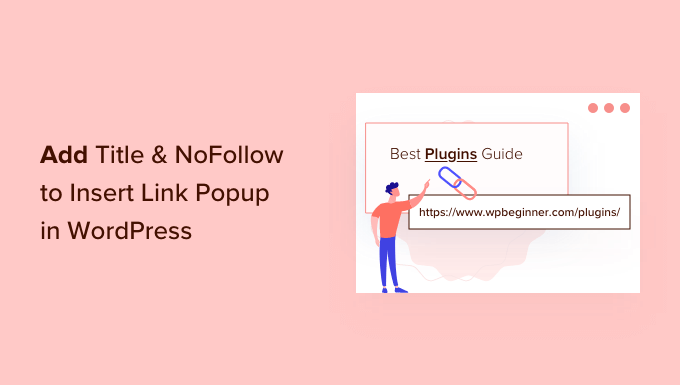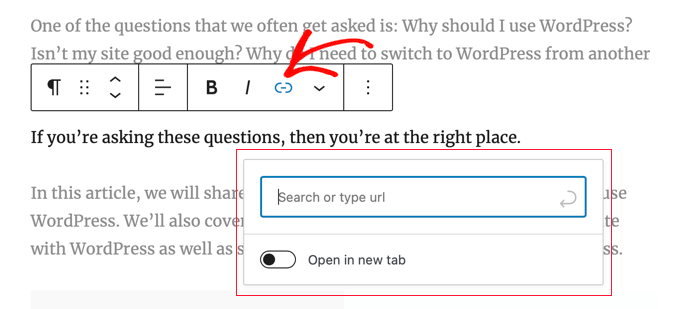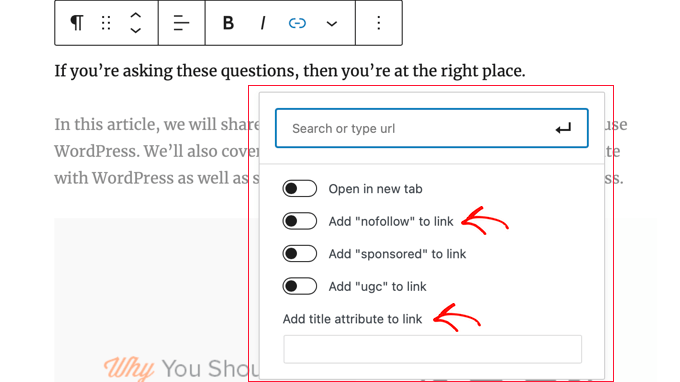Vous voulez connaître quelques ajustements simples que nous faisons chez WPBeginner pour améliorer sérieusement nos liens ? Nous parlons de choses qui boostent à la fois l’expérience utilisateur et le référencement. Nous ajoutons un attribut de titre à chaque lien et utilisons l’identifiant nofollow sur de nombreux liens externes.
L’attribut title peut sembler anodin, mais il fait toute la différence. Il donne aux internautes une petite prévisualisation de la destination d’un lien avant même qu’ils ne cliquent. L’attribut nofollow indique aux moteurs de recherche ce qui est important sur notre site et comment nous voulons partager (ou non) l’autorité des liens.
Mais voici le problème auquel nous nous sommes heurtés : WordPress ne facilite pas l’ajout de l’un ou l’autre de ces éléments. C’est un peu frustrant, non ?
Cet article fournit un guide simple sur la façon d’ajouter des options pour les attributs title et nofollow à la fenêtre surgissante Insert Link dans WordPress, rationalisant ainsi votre flux de travail et stimulant vos efforts de référencement.

Pourquoi ajouter les attributs Title et NoFollow aux liens dans WordPress ?
Lorsque vous rédigez du contenu, vous ajoutez naturellement des liens, n’est-ce pas ? C’est ainsi que vous reliez vos propres publications et pages et que vous pointez vers d’autres ressources utiles. Nous le faisons tout le temps !
Ces liens guident les internautes et leur donnent des informations supplémentaires. Mais un simple lien ne suffit pas toujours. C’est pourquoi nous aimons donner un titre à nos liens. Vous savez, ce petit texte qui apparaît lorsque vous survolez un lien avec votre souris ?
Nous avons trouvé que l’ajout d’un titre est en fait très utile pour les Lecteurs. C’est comme s’il leur donnait une petite prévisualisation ou un indice sur ce qu’ils vont faire s’ils cliquent.
Ce lien renvoie à un article sur la création d’adresses e-mail professionnelles gratuites”, pensent-ils en voyant le titre. Cela rend les choses plus claires et plus rassurantes pour eux.

De plus, et c’est un bonus appréciable, cela peut également donner un petit coup de pouce à votre référencement. Les moteurs de recherche semblent apprécier ce contexte supplémentaire.
Parlons maintenant du nofollow. C’est quelque chose que nous utilisons beaucoup, en particulier lorsque nous créons des liens vers d’autres sites.
En gros, l’attribut nofollow permet de dire aux moteurs de recherche : “Vous pouvez suivre ce lien, mais ne transmettez pas d’autorité de lien à cet autre site à partir de notre site”. Cela peut sembler un peu technique, mais c’est en fait assez simple une fois que l’on a compris.
Les experts en référencement recommandent souvent d’utiliser un attribut nofollow pour les liens externes, et nous avons tendance à être d’accord avec cela pour certaines situations. Il ne s’agit pas d’être hostile ! Il s’agit plutôt de gérer la façon dont l’autorité Link/autrice circule sur le web et de se concentrer sur ce qui est le plus important pour notre importation.
Par exemple, si nous créons un lien vers un site que nous n’approuvons pas entièrement ou s’il s’agit d’un lien sponsorisé, le nofollow est définitivement notre choix.
Mais voici la partie la plus ennuyeuse. Lorsque vous êtes dans WordPress et que vous cliquez sur le bouton “Insérer un lien”, vous remarquerez qu’il n’y a aucune option pour ajouter un titre de lien ou pour rendre un lien “nofollow” ! Vraiment ? Tout ce que vous obtenez, c’est le champ URL du lien et une case à cocher pour l’ouverture dans une nouvelle fenêtre.

C’est un peu basique et, honnêtement, pas très utile pour quiconque se soucie du référencement ou de l’expérience des utilisateurs/utilisatrices. Nous pensons vraiment que WordPress pourrait améliorer cela !
Ceci étant dit, voyons comment ajouter facilement les options title et nofollow à la fenêtre surgissante Insert Link de votre blog WordPress.
Comment ajouter un titre et un NoFollow à la fenêtre surgissante d’un lien dans WordPress
Alors, comment corriger ce problème ? La première chose à faire est d’installer l’extension gratuite All in One SEO Lite. Pour plus de détails, consultez notre guide étape par étape sur l’installation d’une extension WordPress.
Nous recommandons AIOSEO depuis des années – c’est tout simplement la meilleure extension WordPress pour le référencement, à notre avis. Et vous avez uniquement besoin de la version gratuite pour obtenir ces options de liens supplémentaires, ce qui est fantastique. Bien sûr, AIOSEO Pro est encore plus puissant si vous voulez vraiment obtenir un meilleur classement.
Une fois activé, vous devez configurer l’extension à l’aide de l’assistant de configuration d’AIOSEO. Pour des instructions détaillées, consultez notre guide ultime sur la façon de configurer All in One SEO pour WordPress.
Une fois que vous avez fait cela, le plugin ajoutera automatiquement des attributs supplémentaires à la fenêtre contextuelle qui s’affiche lorsque vous cliquez sur le bouton Insérer un lien.
Il s’agit notamment d’un champ de titre et d’options permettant d’ajouter des identifiants nofollow, sponsorisés et UGC (contenu généré par l’utilisateur).

Pour ajouter le titre du lien, il suffit de le taper dans le champ “Ajouter un attribut de titre au lien”. Lorsque vous enregistrerez le lien, AIOSEO appliquera le titre et tous les attributs que vous aurez permutés.
Des publicités d’experts pour ajouter des liens dans WordPress
Nous espérons que ce tutoriel vous a aidé à apprendre comment ajouter les options title et nofollow à la fenêtre surgissante Insert Link dans WordPress. Vous pouvez également consulter nos meilleurs guides sur la façon de créer, suivre et corriger les liens sur votre site WordPress :
- Guide du débutant sur la façon d’ajouter un Link dans WordPress
- Les liens internes pour le référencement : Le guide ultime des meilleures pratiques
- Meilleures extensions de liens internes pour WordPress (automatiques + manuelles)
- Comment suivre les clics de liens et les clics de boutons dans WordPress (méthode facile)
- Comment trouver et corriger les liens corrompus dans WordPress (étape par étape)
Si vous avez aimé cet article, veuillez alors vous abonner à notre chaîne YouTube pour obtenir des tutoriels vidéo sur WordPress. Vous pouvez également nous trouver sur Twitter et Facebook.





Jiří Vaněk
I would like to ask, within the scope of SEO, if I want only external links to have the nofollow attribute. Leave internal links as they are, but set nofollow indiscriminately for all external links. I want this in order for the robot on my website not to follow external links. How to solve it? Through a snippet of code or a plugin?
WPBeginner Support
We have a guide on how to nofollow external links that you should find helpful below
https://www.wpbeginner.com/plugins/how-to-nofollow-all-external-links-in-wordpress/
Admin
Stuart
Hi there,
It’s worth noting this won’t work in the Gutenberg editor.
Cheers.
WPBeginner Support
We’ll be sure to look into updating this article
Admin
Editorial Staff
The article has been updated to reflect a new solution which works in both Gutenberg as well as classic editor.
Admin
Kulwant
can this plugin slow down over website speed ?
WPBeginner Support
Hi Kulwant,
No, it doesn’t affect site speed.
Admin
Bikramjit
Hi,
I have added link of some research journals, they are like authorities. Should I keep those link as nofollow link.
best regards
Bikramjit
John
I read this article today and installed the plugin, but it hasn’t been updated for the last 2 years?
Is it still a safe and good plugin to use then? Or is there a better one by now?
I have seen quite some nofollow plugins but none that include the Title as well.
Any advice would be nice :).
Great article!
WPBeginner Support
Hi John,
We reached out to the plugin author and they have updated the plugin. You can now safely install it on your website.
Admin
Jasmin
Hi, great tutorial!!! Can you please tell me how you added the hyperlink to the “Editorial Staff” text beneath the title?
Theodore Nwangene
This is really a very awesome tutorial,
I understand how important it is to nofollow our external links especially when its an affiliate link and thats what made this post amazing.
A friend was just asking me the other day how to easily make a link nofollow now, which other way will be easier than what you just explained here?
I’m going to forward this post to him right away and will also download the plugin as soon as possible.
Thanks for sharing.
Viacheslav
Isn’t that simpler to add rel=”nofollow” and title manually when adding the link in the TEXT mode? I usually do this with no bother
WPBeginner Support
Yes you can do that too if you find it more convenient.
Admin
Barry Richardson
Am I assuming correctly that each link on a blog would have to be individually set? After all, we might want to “do-follow” some outbound links and “no-follow” others – or we might want to link to a different post on the same site, which typically should be “do-follow”.
WPBeginner Support
Yes this is why this plugin is helpful. You can leave the nofollow box unchecked if you want to create a dofollow link.
Admin
John D
I’very never understood why WP by default has no title attribute to set in its link dialog. Blogger had it in 2008!
WPBeginner Support
WordPress had it too. It was removed in WordPress 4.2.
Admin
Olivia Smith
Do we have to change HTML setting individually for every blog we post ?
WPBeginner Support
No, unless you want to.
Admin
Connor Rickett
The real question is, Why isn’t this isn’t a default feature in WordPress?
I mean, all it needs is a little checkbox in the link section, follow/nofollow, and, poof, powerful new feature. No muss, no fuss, barely any tears.
Mark Corder
“but you don’t want to pass away any link authority to these websites.” …
What exactly is meant by that?
Atila
It means that you don’t want search engines to pick up that link while crawling. The link is there for reference or for whatever reason, and you are not giving him your PR juice. It would be bad to have a website full of dofollow outbound links, especially if they lead to poor content website. Only leave clean links to sites that you care of and are important.
Gulshan
Please make a list of Perfect plugin to manage all over SEO.